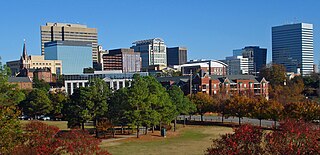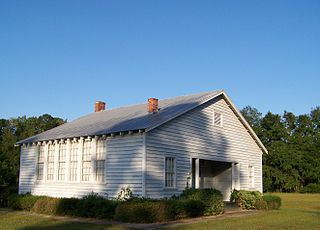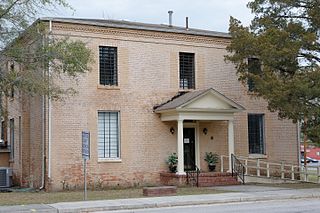
Columbia is the capital and second-largest city of the U.S. state of South Carolina, with a population estimate of 131,674 as of 2019. The city serves as the county seat of Richland County, and a portion of the city extends into neighboring Lexington County. It is the center of the Columbia metropolitan statistical area, which had a population of 767,598 as of the 2010 United States Census, growing to 832,666 by July 1, 2018, according to 2018 U.S. Census estimates. This makes it the 70th-largest metropolitan statistical area in the nation, as estimated by the United States Census Bureau as of July 1, 2018. The name Columbia is a poetic term used for the United States, derived from the name of Christopher Columbus, who explored for the Spanish Crown. Columbia is often abbreviated as Cola, leading to its nickname as "Soda City."

Hampton is a town in Hampton County, South Carolina, United States. The population was 2,808 at the 2010 census. It is the county seat of Hampton County. The town and the county are named after Wade Hampton III, a Confederate general in the Civil War.

The Jamestown Exposition was one of the many world's fairs and expositions that were popular in the United States in the early part of the 20th century. Commemorating the 300th anniversary of the founding of Jamestown in the Virginia Colony, it was held from April 26 to December 1, 1907, at Sewell's Point on Hampton Roads, in Norfolk, Virginia. It celebrated the first permanent English settlement in the present United States. In 1975, the 20 remaining exposition buildings were included on the National Register of Historic Places as a national historic district.

Somerset Place is a former plantation near Creswell in Washington County, North Carolina, along the northern shore of Lake Phelps, and now a State Historic Site that belongs to the North Carolina Department of Natural and Cultural Resources. Somerset Place operated as a plantation from 1785 until 1865. Before the end of the American Civil War, Somerset Place had become one of the Upper South's largest plantations.

Old Salem is a historic district of Winston-Salem, North Carolina that was originally settled by the Moravian community in 1766 . This small city features a living history museum that interprets the restored Moravian community. The non-profit organization began its work in 1950, although some private residents had restored buildings earlier. As the Old Salem Historic District, it was declared a National Historic Landmark (NHL) in 1966. and expanded in 2016. The district showcases the culture of the Moravian settlement in North Carolina during the 18th and 19th centuries, communal buildings, churches, houses, and shops.

Wright Brothers National Memorial, located in Kill Devil Hills, North Carolina, commemorates the first successful, sustained, powered flights in a heavier-than-air machine. From 1900 to 1903, Wilbur and Orville Wright came here from Dayton, Ohio, based on information from the U.S. Weather Bureau about the area's steady winds. They also valued the privacy provided by this location, which in the early twentieth century was remote from major population centers.

Auldbrass Plantation or Auldbrass is located in Beaufort County, South Carolina, near the town of Yemassee. The main house, stable complex and kennels were designed and built by Frank Lloyd Wright from 1940–1951. It is one of two structures that Wright designed in South Carolina.

Hampton Plantation, also known as Hampton Plantation House and Hampton Plantation State Historic Site, is a historic plantation, now a state historic site, north of McClellanville, South Carolina. The plantation was established in 1735, and its main house exhibits one of the earliest known examples in the United States of a temple front in domestic architecture. It is also one of the state's finest examples of a wood frame Georgian plantation house. It was declared a National Historic Landmark in 1970.

Temple Sinai is an historic Reform synagogue located at 11 Church Street on the corner of West Hampton Avenue, in Sumter, South Carolina, United States. Built in 1912 of brick in the Moorish Revival style, Temple Sinai was added to the National Register of Historic Places on January 21, 1999. It is also known as Congregation Sinai, whose official name is the Sumter Society of Israelites. It also houses the Temple Sinai Jewish History Center which opened in June 2018.

The Hampton–Preston House located at 1615 Blanding Street in Columbia, South Carolina, is a historic mansion that was the home of members of the prominent Hampton family. It was listed in the National Register of Historic Places on July 29, 1969.

The Mammoth Hot Springs Historic District in Yellowstone National Park comprises the administrative center for the park. It is composed of two major parts: Fort Yellowstone, the military administrative center between 1886–1918, and now a National Historic Landmark, and a concessions district which provides food, shopping, services, and lodging for park visitors and employees.

The Woodrow Wilson Family Home is located in Columbia, South Carolina and was one of the childhood homes of the 28th President Woodrow Wilson. He lived in the house from 1871 to 1875.

Conway Post Office is a historic post office building located at Conway in Horry County, South Carolina. It was designed and built 1935–1936, and is one of a number of post offices in South Carolina designed by the Office of the Supervising Architect of the Treasury Department under Louis A. Simon. The building is in the Classical Revival style and is a one-story brick building that features an off-center entrance with large fanlight above. It was the first Federal post office built in the city of Conway until it was replaced by a new federal post office in 1977. In 1981, the renovated building was reopened as the Horry County Museum, which in 2014 moved to a new location in the Burroughs School.

The C.P. Quattlebaum Office is a historic law office building located at Conway in Horry County, South Carolina. It was built about 1860 as a residence. It was used as a law office for the firm Johnson, Johnson, and Quattlebaum after 1876 until 1929. It also housed the first bank in town; The Bank of Conway, from 1893 until 1899. It was moved to its present location about 1900.

Hampton County Courthouse is a historic courthouse building located at Hampton, Hampton County, South Carolina. It was built in 1878, and was originally a two-story structure constructed of brick laid in the common bond pattern in the Italianate style. In 1925, the courthouse was renovated and additional wings were added to the front and rear facades. Also located on the property are two small modern annexes situated directly to the rear of the courthouse, and a two-story brick annex.

Hampton Colored School is a historic school for African-American students located at Hampton, Hampton County, South Carolina. It was built in 1929, and is a one-story, front-gable, rectangular, frame building. It has clapboard siding, a tin roof, exposed rafters, and a brick pier foundation. It remained the only black school in Hampton until 1947, when Hampton Colored High School was built and the Hampton Colored School became the lunchroom for the high school.

Gravel Hill Plantation is a historic hunting plantation complex located at Garnett, Hampton County, South Carolina. It was built in 1910, and is the 20-acre core of a large hunting plantation that includes eleven historic buildings; nine of them were designed and built by the owner, Robert Palmer Huntington. The complex includes three residential buildings, a kitchen and dining facility, ice house, stables and ancillary service buildings. Also on the property are a corn crib and a tenant's house. It is a rare example of the Adirondack or Rustic Style in South Carolina.

Hampton County Jail, also known as Old Hampton County Jail and Hampton County Museum, is a historic jail located at Hampton, Hampton County, South Carolina. It was built in 1879–1880, and is a two-story, three-bay-wide brick building, with a central, one-story entry portico on the front facade. The jailkeeper's living quarters occupied the first floor, while the second floor was dedicated to the cellblocks. The jail was dramatically altered about 1925, and a third time in the 1960s. The jail was the only holding facility for newly arrested persons in Hampton County until it closed in 1976.

Good Samaritan-Waverly Hospital, also known as “Good Sam” Hospital and Waverly Hospital, is a historic hospital for African-American patients located in Columbia, South Carolina. It was built in 1952, and is a two-story, brick building in the Moderne style. The hospital housed a pharmacy, laboratory, X-ray room, staff dining room, two operating rooms, and 50 beds to service the local community. The hospital closed in August 1973.

Milton State Bank, also known as the Branch Bank of the Bank of the State of North Carolina at Milton, is a historic bank building located at Milton, Caswell County, North Carolina. It was built in 1860, and is a two-story, three bay by five bay, Greek Revival style brick building. It housed a bank on the first floor and residential unit on the second. It housed a bank until about 1914. From about 1914 to 1963 the building served as a combination residence and the Milton Post Office. It was subsequently converted to residential usage.
























